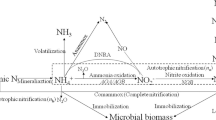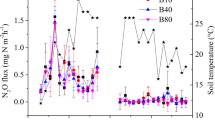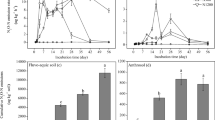Abstract
Purpose
The work aimed to (1) better understand how C rate and type affecting N2O emissions when combined application with different N forms in a strong ammonia oxidation soil, (2) further explore the tradeoff and mechanism of C availability to N transformations, and (3) provide evidence for making targeted N2O mitigation measures in these kinds of agricultural soils.
Materials and methods
The soil was collected from a typical farmer’s field in Quzhou, Hebei province, China, classified as calcareous Cambisols (FAO classification system) and characterized with high pH (7.72), low organic C (9.1 g kg−1), and a strong ammonia oxidation potential. Two microcosm incubations were conducted in laboratory under 20 °C and 70% WFPS (water-filled pore space), and the soils were amended with different glucose rates (0, 0.5, 1.0, 2.0, 4.0 mg C kg−1) in Exp I, and with different C sources (glucose, pectin, starch, cellulose, lignin, straw) in Exp II, meanwhile with NH4+ or NO3−-based fertilizer addition. 480 g (equivalent to oven-dried weight) of pre-incubated soil was placed in a glass jar (1165 mL volume) and adjusted to a field bulk density of 1.34 g cm−3. All the glass jars were placed randomly and incubated for 15 days under aerobic condition.
Results and discussion
Alone application of NH4+ released more N2O (peak at 16.27 μg N kg−1) than alone NO3− application. However, combined application of glucose with NO3− could emit more N2O than when combined with NH4+, and the highest N2O peak value was found in 0.5 g kg−1of glucose. When pectin is combined with NH4+, resulted in higher accumulated N2O emissions than other C sources, while applying straw and cellulose had negligible effects on N2O emissions but enhanced CO2 emissions under the incubation conditions. Glucose and pectin were identified as two labile C sources, significantly enhanced N2O emissions. As expected, C addition could stimulate mineral N immobilization.
Conclusions
Combined application of C and N enhanced N2O and CO2 emissions albeit to different extents. A higher accumulated N2O emission was found when C/N ratio was lower (12.5). The stimulating effect of glucose and pectin as labile C sources with N addition on N2O production should be considered, especially in soils with high pH, low organic C, and a strong ammonia oxidation potential. Therefore, it may have the potential to mitigate N2O emissions from the field when avoiding applying both N and C especially rich in glucose and pectin together.






Similar content being viewed by others
References
Ameloot N, Maenhout P, De Neve S, Sleutel S (2016) Biochar-induced N2O emission reductions after field incorporation in a loam soil. Geoderma 267:10–16
Baggs EM (2011) Soil microbial sources of nitrous oxide: recent advances in knowledge, emerging challenges and future direction. Curr Opin Env Sust 3:321–327
Bao QL, Ju XT, Gao B, Qu Z, Christie P, Lu YH (2012) Response of nitrous oxide and corresponding bacteria to managements in an agricultural soil. Soil Sci Soc Am J 76:130–141
Bengtsson G, Bengtson P, Mansson KF (2003) Gross nitrogen mineralization-, immobilization-, and nitrification rates as a function of soil C/N ratio and microbial activity. Soil Biol Biochem 35:143–154
Booth MS, Stark JM, Rastetter E (2005) Controls on nitrogen cycling in terrestrial ecosystems: a synthetic analysis of literature data. Ecol Monogr 75:139–157
Bouwman AF, Boumans LJM, Batjes NH (2002) Emissions of N2O and NO from fertilized fields: summary of available measurement data. Glob Biogeochem Cycles 16:1058
Burger M, Jackson LE (2003) Microbial immobilization of ammonium and nitrate in relation to ammonification and nitrification rates in organic and conventional cropping systems. Soil Biol Biochem 35:29–36
Butterbach-Bahl K, Baggs EM, Dannenmann M, Kiese R, Zechmeister-Boltenstern S (2013) Nitrous oxide emissions from soils: how well do we understand the processes and their controls? Phil Trans R Soc B 368:20130122
Cheng Y, Cai ZC, Chang SX, Wang J, Zhang JB (2012) Wheat straw and its biochar have contrasting effects on inorganic N retention and N2O production in a cultivated black Chernozem. Biol Fert Soils 48:941–946
Cheng Y, Wang J, Wang JY, Chang SX, Wang SQ (2017) The quality and quantity of exogenous organic carbon input control microbial NO3− immobilization: a meta-analysis. Soil Biol Biochem 115:357–363
Cui F, Yan G, Zhou Z, Zheng X, Deng J (2012) Annual emissions of nitrous oxide and nitric oxide from a wheat–maize cropping system on a silt loam calcareous soil in the North China plain. Soil Biol Biochem 48:10–19
De Catanzaro, Beauchamp EG (1985) The effect of some carbon substrates on denitrification rates and carbon utilization in soil. Biol Fert Soils 1:183–187
Ding WX, Chen ZM, Yu HY, Luo JF, Yoo GY, Xiang J, Zhang HJ, Yuan JJ (2015) Nitrous oxide emission and nitrogen use efficiency in response to nitrophosphate, N-(n-butyl) thiophosphoric triamide and dicyandiamide of a wheat cultivated soil under sub-humid monsoon conditions. Biogeosciences 12:803–815
Dobbie KE, Smith KA (2003) Impact of different forms of N fertilizer on N2O emissions from intensive grassland. Nutr Cycl Agroecosyst 67:37–46
Drawing Down N2O to Protect Climate and the Ozone Layer (2013) A UNEP (United Nations Environment Programme) synthesis report. Nairobi, Kenya
FAO (2015) Save Food: Global Initiative on Food Loss and Waste Reduction. Food and Agriculture Organization of the United Nations (FAO), Vialedelle Terme di Caracalla 00153, Rome, Italy
Freppaz M, Williams BL, Edwards AC, Scalenghe R, Zanini E (2007) Labile nitrogen, carbon, and phosphorus pools and nitrogen mineralization and immobilization rates at low temperatures in seasonally snow-covered soils. Bio Fert Soils 43:519–529
Gao B, Ju X, Su F, Meng Q, Oenema O, Christie P, Chen X, Zhang F (2014) Nitrous oxide and methane emissions from optimized and alternative cereal cropping systems on the North China plain: a two-year field study. Sci Total Environ 472:112–124
Granli T, Bøckman OC (1994) Nitrous oxide from agriculture. Norwegian J of Agr Sci 12:1–128
Hart SC, Stark JM, Davidson EA, Firestone MK (1994) Nitrogen mineralization, immobilization and nitrification. In: Weaver RW et al (eds) Methods of soil analysis, part 2 microbiological and biochemical properties. Soil Science Society of America, Madison, pp 985–1018
Huang T, Gao B, Christie P, Ju XT (2013) Net global warming potential and greenhouse intensity in a double-cropping cereal rotation as affected by nitrogen and straw management. Biogeosciences 10:7897–7911
Huang T, Gao B, Hu XK, Lu X, Well R, Christie P, Bakken LR, Ju XT (2014) Ammonia-oxidation as an engine to generate nitrous oxide in an intensively managed calcareous fluvo-aquic soil. Sci Rep 4:3950
IPCC (2007) Climate change 2007: the physical science basis. In: Solomon S, Qin D, Manning M (eds) Contribution of working group I to the fourth assessment report of the intergovernmental panel on climate change. Cambridge University Press, Cambridge
IPCC (2013) Climate change 2013: The physical science basis. Stocker T F, Qin D, Plattner G K, Tignor M, Allen S K, Boschung J, Nauels A, Xia Y, Bex V and Midgley P M (eds) Contribution of Working Group I to the Fifth Assessment Report of the Intergovernmental Panel on Climate Change, Cambridge University Press, Cambridge, United Kingdom and New York
Ju XT, Zhang C (2017) Nitrogen cycling and environmental impacts in upland agricultural soils in North China: a review. J Integr Agr 16:2848–2862
Ju X, Lu X, Gao Z, Chen X, Su F, Kogge M, Romheld V, Christie P, Zhang F (2011) Processes and factors controlling N(2)O production in an intensively managed low carbon calcareous soil under sub-humid monsoon conditions. Environ Pollut 159:1007–1016
Kool DM, Wrage N, Zechmeister-Boltenstern S, Pfeffer M, Brus D, Oenema O, Van Groenigen JW (2010) Nitrifier denitrification can be a source of N2O from soil: a revised approach to the dual-isotope labelling method. Eur J Soil Sci 61:759–772
Lan T, Liu R, Suter H, Deng O, Gao X, Luo L, Yuan S, Wang CQ, Chen DL (2019) Stimulation of heterotrophic nitrification and N2O production, inhibition of autotrophic nitrification in soil by adding readily degradable carbon. J Soils Sediment:1–10. https://doi.org/10.1007/s11368-019-02417-0
Larsen KL, McCartney DM (2000) Effect of C : N ratio on microbial activity and N retention: bench-scale study using pulp and paper biosolids. Compost Sci Util 8:147–159. https://doi.org/10.1080/1065657X.2000.10701760
Li D, Watson CJ, Ming JI, Lalor S, Rafique R, Hyde B, Lanigan G, Richards K, Holden NM, Humphreys J (2013) A review of nitrous oxide mitigation by arm nitrogen management in temperate grassland-based agriculture. J Environ Manag 128:893–903
Ma Q, Wu Z, Pan F, Wang J, Zhou H, Jiang C, Xu YG, Yu WT (2016) Effect of glucose addition on the fate of urea– 15N in fixed ammonium and soil microbial biomass N pools. Eur J Soil Biol 75:168–173
Magill AH, Aber JD (2000) Variation in soil net mineralization rates with dissolved organic carbon additions. Soil Biol Biochem 32:597–601
Mehnaz KR, Keitel C, Dijkstra FA (2018) Effects of carbon and phosphorus addition on microbial respiration, N2O emission, and gross nitrogen mineralization in a phosphorus-limited grassland soil. Bio Fert Soils 54:481–493
Miller MN, Zebarth BJ, Dandie CE, Burton DL, Goyer C, Trevors JT (2008) Crop residue influence on denitrification, N2O emissions and denitrifier community abundance in soil. Soil Bio Biochem 40:2553–2562
Moritsuka N, Yanai J, Mori K, Kosaki T (2004) Biotic and abiotic processes of nitrogen immobilization in the soil-residue interface. Soil Biol Biochem 36:1141–1148
Mosier AR, Halvorson AD, Reule CA, Liu XJ (2006) Net global warming potential and greenhouse gas intensity in irrigated cropping systems in northeastern Colorado. J Environ Qual 35:1584–1598
Murray PJ, Hatch DJ, Dixon ER, Stevens RJ, Laughlin RJ, Jarvis SC (2004) Denitrification potential in a grassland subsoil: effect of carbon substrates. Soil Biol Biochem 36:545–547
Myrold DD, Posavatz NR (2007) Potential importance of bacteria and fungi in nitrate assimilation in soil. Soil Biol Biochem 39:1737–1743
Pilegaard K (2013) Processes regulating nitric oxide emissions from soils. Philos T R Soc B 368:20130126
Qiu SJ, Ju XT, Ingwersen J, Guo ZD, Stange CF, Bisharat R, Streck T, Christie P, Zhang FS (2013) Role of carbon substrates added in the transformation of surplus nitrate to organic nitrogen in a calcareous soil. Pedosphere 23:205–212
Ravishankara AR, Daniel JS, Portmann RW (2009) Nitrous oxide (N2O): the dominant ozone-depleting substance emitted in the 21st century. Science 326:123–125
Rivett MO, Buss SR, Morgan P (2008) Nitrate attenuation in groundwater: a review of biogeochemical controlling process. Water Res 42:4215–4232
Schimel JP, Bennett J (2004) Nitrogen mineralization: challenges of a changing paradigm. Ecology 85:591–602
Shcherbak I, Millar N, Robertson GP (2014) Global metaanalysis of the nonlinear response of soil nitrous oxide (N2O) emissions to fertilizer nitrogen. Proc Natl Acad Sci USA 111:9199–9204
Smith KA, Dobbie KE, Thorman R, Watson CJ, Chadwick DR, Yamulki S, Ball BC (2012) The effect of N fertiliser forms on nitrous oxide emissions from UK arable land and grassland. Nutr Cycl Agroecosyst 93:127–149
Song XT, Ju XT, Topp CFE, Rees RM (2019) Oxygen regulates nitrous oxide production directly in agricultural soils. Environ Sci Technol 53:12539–12547
Trinsoutrot I, Recous S, Bentz B, Lineres M, Cheneby D, Nicolardot B (2000) Biochemical quality of crop residues and carbon and nitrogen mineralization kinetics under nonlimiting nitrogen conditions. Soil Sci Soc Am J 64:918–926
Wan Y, Ju X, Ingwersen J, Schwarz U, Stange CF, Zhang F, Streck T (2009) Gross nitrogen transformations and related nitrous oxide emissions in an intensively used calcareous soil. Sci Soc Am J 73:102
Wang LF, Cai ZC, Yang LF, Meng L (2005) Effects of disturbance and glucose addition on nitrousoxide and carbon dioxide emissions from a paddy soil. Soil Till Res 82:185–194
Wrage N, Velthof GL, van Beusichem ML, Oenema O (2001) Role of nitrifier denitrification in the production of nitrous oxide. Soil Bio Biochem 33:1723–1732
Wrage N, van Groenigen JW, Oenema O, Baggs EM (2005) A novel dual-isotope labelling method for distinguishing between soil sources of N2O. Rapid Commun Mass Sp 19:3298–3306
Yang L, Zhang X, Ju X (2017) Linkage between N2O emission and functional gene abundance in an intensively managed calcareous fluvo-aquic soil. Sci Rep 7:43283
Yokoyama K, Kai H, Naklang K (1992) Heterotrophic nitrification by sodium chloride-tolerant fungi in soils added with sodium-chloride. Soil Sci Plant Nutr 38:757–762
Zheng XH, Mei BL, Wang YH, Xie BH, Wang YS, Dong HB, Xu H, Chen GX, Cai ZC, Yue J, Gu JX, Su F, Zou JW, Zhu JG (2008) Quantification of N2O fluxes from soil-plant systems may be biased by the applied gas chromatograph methodology. Plant Soil 311:211–234
Zhu X, Burger M, Doane TA, Horwath WR (2013) Ammonia oxidation pathways and nitrifier denitrification are significant sources of N2O and NO under low oxygen availability. Proc Natl Acad Sci U S A 110:6328–6333
Zhu T, Meng T, Zhang J, Zhong W, Mueller C, Cai Z (2015) Fungi-dominant heterotrophic nitrification in a subtropical forest soil of China. J Soils Sediments 15:705–709
Zhu GD, Zhang JB, Müller C, Rees RM, Thorman RE, Sylvester-Bradley R (2019a) Effects of the nitrification inhibitor DMPP (3,4-dimrthylpyrazole phosphate) on gross N transformation rates and N2O emissions. Biol Fert Soils 55:603–615
Zhu GD, Song XT, Ju XT, Zhang JB, Christoph M, Sylvester-Bradley R, Thorman RE, Bingham I, Rees RM (2019b) Gross N transformation rates and related N2O emissions in Chinese and UK agricultural soils. Sci Total Environ 666:176–186
Funding
This work was supported by the National Natural Science Foundation of China (41830751, 41807036) and the National Key Research and Development Program of China (2017YFD0200105).
Author information
Authors and Affiliations
Corresponding author
Additional information
Responsible editor: Zucong Cai
Publisher’s note
Springer Nature remains neutral with regard to jurisdictional claims in published maps and institutional affiliations.
Electronic supplementary material
Supplementary material
(DOCX 24 kb)
Rights and permissions
About this article
Cite this article
Yang, L., Liu, R. & Ju, X. Effect of carbon rate and type amended with ammonium or nitrate on nitrous oxide emissions in a strong ammonia oxidation soil. J Soils Sediments 20, 1253–1263 (2020). https://doi.org/10.1007/s11368-019-02524-y
Received:
Accepted:
Published:
Issue Date:
DOI: https://doi.org/10.1007/s11368-019-02524-y




